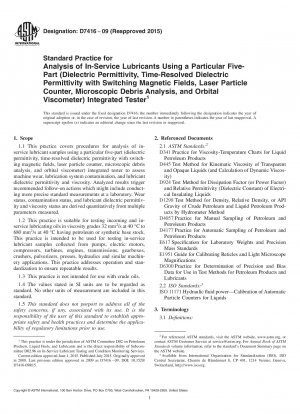ASTM D7416-09(2015)
Standard Practice for Analysis of In-Service Lubricants Using a Particular Five-Part (Dielectric Permittivity, Time-Resolved Dielectric Permittivity with Switching Magnetic Fields, Laser Particle Counter, Microscopic Debris Analysis, and Orbital Vis
- Standard No.
- ASTM D7416-09(2015)
- Release Date
- 2009
- Published By
- American Society for Testing and Materials (ASTM)
- Status
- Replace By
- ASTM D7416-09(2020)
- Latest
- ASTM D7416-09(2020)
- Scope
5.1 In-plant Oil Analysis—The particular five-part integrated tester practice is primarily used by plant maintenance personnel desiring to perform on-site analysis of as-received and in-service lubricating oils.
5.2 Detect Common Lubrication Problems—The software application interprets data from integration of multiple sensing technologies to detect common lubrication problems from inadvertent mixing of dissimilar lubricant viscosity grades and from particulate or moisture contamination. The redundant views of ferrous particulates (sensor 2), all particulates larger than 48201;μm (sensor 3), and all solid particulates larger than filter patch pore size (patch maker) provides screening for oil wetted mechanical system failure mechanisms from incipient to catastrophic stages.
5.3 Supported by Off-Site Lab Analysis—The particular five-part integrated tester is normally used in conjunction with an off-site laboratory when exploring the particular nature of an alarming oil sample. An off-site laboratory should be consulted for appropriate additional tests.
1.1 This practice covers procedures for analysis of in-service lubricant samples using a particular five-part (dielectric permittivity, time-resolved dielectric permittivity with switching magnetic fields, laser particle counter, microscopic debris analysis, and orbital viscometer) integrated tester to assess machine wear, lubrication system contamination, and lubricant dielectric permittivity and viscosity. Analyzed results trigger recommended follow-on actions which might include conducting more precise standard measurements at a laboratory. Wear status, contamination status, and lubricant dielectric permittivity and viscosity status are derived quantitatively from multiple parameters measured.
1.2 This practice is suitable for testing incoming and in-service lubricating oils in viscosity grades 328201;mm2/s at 408201;°C to 6808201;mm2/s at 408201;°C having petroleum or synthetic base stock. This practice is intended to be used for testing in-service lubricant samples collected from pumps, electric motors, compressors, turbines, engines, transmissions, gearboxes, crushers, pulverizers, presses, hydraulics and similar machinery applications. This practice addresses operation and standardization to ensure repeatable results.
1.3 This practice is not intended for use with crude oils.
1.4 The values stated in SI units are to be regarded as standard. No other units of measurement are included in this standard.
1.5 This standard does not purport to address all of the safety concerns, if any, associated with its use. It is the responsibility of the user of this standard to establish appropriate safety and health practices and determine the applicability of regulatory limitations prior to use.
ASTM D7416-09(2015) Referenced Document
- ASTM D1298 Standard Test Method for Density, Relative Density (Specific Gravity), or API Gravity of Crude Petroleum and Liquid Petroleum Products by Hydrometer Method
- ASTM D341 Standard Test Method for Viscosity-Temperature Charts for Liquid Petroleum Products
- ASTM D4057 Standard Practice for Manual Sampling of Petroleum and Petroleum Products
- ASTM D4177 Standard Practice for Automatic Sampling of Petroleum and Petroleum Products
- ASTM D445 Standard Test Method for Kinematic Viscosity of Transparent and Opaque Liquids (the Calculation of Dynamic Viscosity)
- ASTM D6300 Standard Practice for Determination of Precision and Bias Data for Use in Test Methods for Petroleum Products and Lubricants
- ASTM D924 Standard Test Method for Dissipation Factor (or Power Factor) and Relative Permittivity (Dielectric Constant) of Electrical Insulating Liquids
- ASTM E1951 Standard Guide for Calibrating Reticles and Light Microscope Magnifications
- ASTM E617 Standard Specification for Laboratory Weights And Precision Mass Standards
- ISO 11171 Hydraulic fluid power — Calibration of automatic particle counters for liquids
ASTM D7416-09(2015) history
- 2020 ASTM D7416-09(2020) Standard Practice for Analysis of In-Service Lubricants Using a Particular Five-Part (Dielectric Permittivity, Time-Resolved Dielectric Permittivity with Switching Magnetic Fields, Laser Particle Coun
- 2009 ASTM D7416-09(2015) Standard Practice for Analysis of In-Service Lubricants Using a Particular Five-Part (Dielectric Permittivity, Time-Resolved Dielectric Permittivity with Switching Magnetic Fields, Laser Particle Counter, Microscopic Debris Analysis, and Orbital Vis
- 2009 ASTM D7416-09 Standard Practice for Analysis of In-Service Lubricants Using a Particular Five-Part (Dielectric Permittivity, Time-Resolved Dielectric Permittivity with Switching Magnetic Fields, Laser Particle Counter, Microscopic Debris Analysis, and Orbital Viscome
- 2008 ASTM D7416-08 Standard Practice for Analysis of In-Service Lubricants Using a Particular Five-Part (Dielectric Permittivity, Time-Resolved Dielectric Permittivity with Switching Magnetic Fields, Laser Particle Coun
